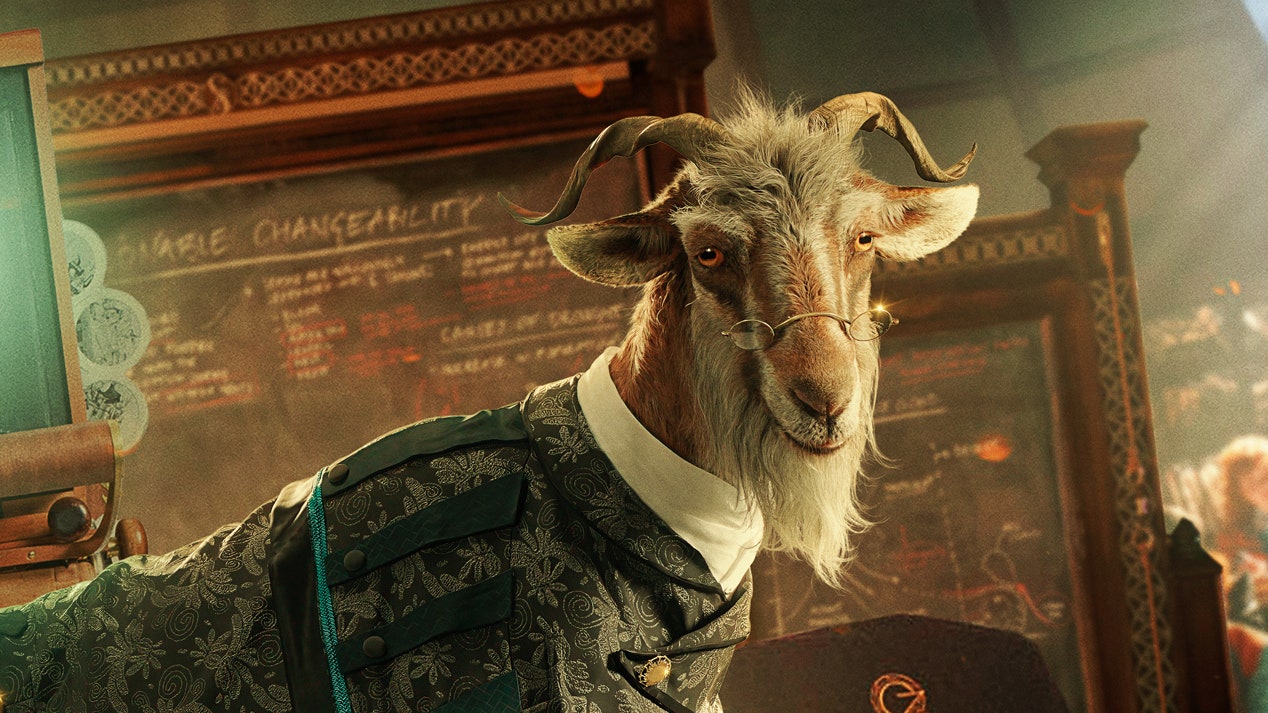(In the stage show, the relatively humanoid Doctor Dillamond—originated on Broadway by actor William Youmans—wears a shaggy floor-length coat, wool vest, and a ribbon bow tie, in addition to a somewhat frightening prosthetic goat mask.)
“But then thinking about when he is at home and off the clock [and] out of the classroom, and Elphaba follows him to his home where he’s meeting with the rest of the animal community at Shiz, what is that comfort place for him? How does he represent himself?” Tazewell says. Someone like Dillamond would likely have the self-assured, lived-in wardrobe of an older man (one imagines the goat professor might thrive among the well-heeled gentlemen of Pitti Uomo), and a comfortable wheat-toned cardigan fit the bill. The four-legged cut of the cardigan, he adds, was similar to a dog’s coat or a horse’s turnout blanket, and like many of the characters’ costumes, it features a slightly asymmetrical closure.
“The way that [the CGI team was] able to render the texture—you know, I think I actually have that sweater myself,” Tazewell says, laughing. “I was just looking over in the corner, I’ve got a hooded sweater very similar to the color and quality. They were able to capture a realism that was really wonderful.”
Dillamond’s costuming factored into a larger conversation Tazewell and his team were having about what sorts of fibers and textiles would exist in Oz; more specifically, they were mindful of which materials Ozians, both animal and human, would find culturally acceptable to wear.
“We definitely didn’t want to have anything that had fur or that was obviously an animal product, like no feathers or that kind of thing, because we didn’t want to dip into this misuse of animals within this world overall,” says Tazewell, who imagines that Oz’s leather-like garments might instead be constructed from bark or cork. “The whole way through, it was very important to make sure that whatever fibers that we were using, that it was fabric,” he continues, “it was either gonna be a silk or cotton. Could be a wool or a hair that was shorn maybe, but that was kind of on the edge. Definitely not leather.” (Surely at least one Shiz grad student has written a synoptic dissertation on veganism in Oz.)
“It was a little tricky,” he adds, but “we wanted to just make sure that we honored that and that it wasn’t present within the design in an obvious way.”
“I love Bode,” says Tazewell, who personally owns a suit and several shirts from the New York City brand. “I love that sensibility. If that sensibility accidentally worked its way into the design, you know, more power to it. But that wasn’t what was front and center necessarily.
“In many ways, the way that I was using asymmetry in some of the shapes are reflective of me and my fashion sensibility, and therefore there’s a connection to fashion overall,” he continues. “Hopefully [the costuming is] engaging in a modern way but holds it to this fantasy world that we’re creating. I think it’s working on both sides.”
Plus, Tazewell adds with a chuckle: “If Dr. Dillamond is fashion-forward, that’s great. That’s fine for me as well.”

